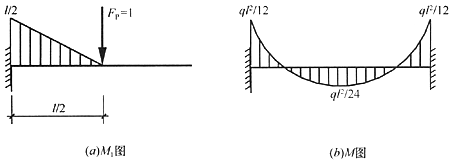图A所示结构(EI=常数)的弯矩图如图B所示,则截面C的竖向位移Acv为()。

A、A
B、B
C、C
D、D
参考答案:A
解析:
取下图(A)所示的基本结构,作出单位荷载作用下的弯矩图M1图,又已知超静定梁的最后弯矩图如图(B),由图乘法得:


[点评] 本题考察超静定结构的位移计算,注意选择合理的基本结构有利于图乘,考生可以选择简支梁作为基本结构进行求解。
图A所示结构(EI=常数)的弯矩图如图B所示,则截面C的竖向位移Acv为()。

A、A
B、B
C、C
D、D
参考答案:A
解析:
取下图(A)所示的基本结构,作出单位荷载作用下的弯矩图M1图,又已知超静定梁的最后弯矩图如图(B),由图乘法得:


[点评] 本题考察超静定结构的位移计算,注意选择合理的基本结构有利于图乘,考生可以选择简支梁作为基本结构进行求解。